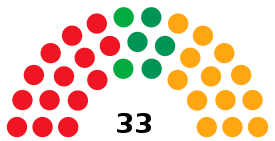Riojan regional election, 1987
|
| |||||||||||||||||||||||||||||||||||||||||||||||||||||||||||||||||||||||||||
| |||||||||||||||||||||||||||||||||||||||||||||||||||||||||||||||||||||||||||
All 33 seats in the General Deputation of La Rioja 17 seats needed for a majority | |||||||||||||||||||||||||||||||||||||||||||||||||||||||||||||||||||||||||||
|---|---|---|---|---|---|---|---|---|---|---|---|---|---|---|---|---|---|---|---|---|---|---|---|---|---|---|---|---|---|---|---|---|---|---|---|---|---|---|---|---|---|---|---|---|---|---|---|---|---|---|---|---|---|---|---|---|---|---|---|---|---|---|---|---|---|---|---|---|---|---|---|---|---|---|---|
| Opinion polls | |||||||||||||||||||||||||||||||||||||||||||||||||||||||||||||||||||||||||||
| Registered |
201,738 | ||||||||||||||||||||||||||||||||||||||||||||||||||||||||||||||||||||||||||
| Turnout |
146,258 (72.5%) | ||||||||||||||||||||||||||||||||||||||||||||||||||||||||||||||||||||||||||
| |||||||||||||||||||||||||||||||||||||||||||||||||||||||||||||||||||||||||||
| |||||||||||||||||||||||||||||||||||||||||||||||||||||||||||||||||||||||||||
The 1987 Riojan regional election was held on Wednesday, 10 June 1987, to elect the 2nd General Deputation of the Autonomous Community of La Rioja. All 33 seats in the General Deputation were up for election. The election was held simultaneously with regional elections in twelve other autonomous communities and local elections all throughout Spain, as well as the 1987 European Parliament election.
The Spanish Socialist Workers' Party (PSOE) came first by winning the most votes and seats, but lost its absolute majority and suffered an important loss of support from 1983. As a result, a coalition government was formed between the second and fourth-most voted parties: the People's Alliance (AP), which lost votes and seats from the previous election as a result of the breakup of the People's Coalition, and the Progressive Riojan Party (PRP). Together, they had 15 seats, one more than the PSOE, and were able to get AP leader, Joaquín Espert, elected thanks to the decisive abstention of the Democratic and Social Centre (CDS), which became the third political force in the community with 4 seats and 10.8% of the share.
The AP-PRP coalition would only last until January 1989, however; from that date, the PRP would leave the coalition, resulting in a minority AP government until 1990, when a motion of censure against Espert would result in the PSOE returning to government, thanks to the vote of the PRP deputies and a CDS deserter.
Overview
Electoral system
The General Deputation of La Rioja was the devolved, unicameral legislature of the autonomous community of La Rioja, having legislative power in regional matters as defined by the Spanish Constitution and the Riojan Statute of Autonomy, as well as the ability to vote confidence in or withdraw it from a President of the Autonomous Community.[1] Voting for the General Deputation was on the basis of universal suffrage, which comprised all nationals over eighteen, registered in La Rioja and in full enjoyment of their political rights.
The 33 members of the General Deputation of La Rioja were elected using the D'Hondt method and a closed list proportional representation, with a threshold of 5 percent of valid votes—which included blank ballots—being applied regionally. Parties not reaching the threshold were not taken into consideration for seat distribution.[1][2]
The electoral law provided that parties, federations, coalitions and groupings of electors were allowed to present lists of candidates. However, groupings of electors were required to secure the signature of at least 1 percent of the electors registered in La Rioja. Electors were barred from signing for more than one list of candidates. Concurrently, parties and federations intending to enter in coalition to take part jointly at an election were required to inform the relevant Electoral Commission within ten days of the election being called.[2][3][4]
Election date
The term of the General Deputation of La Rioja expired four years after the date of its previous election. The election Decree was required to be issued no later than the twenty-fifth day prior to the date of expiry of parliament and published on the following day in the Official Gazette of La Rioja, with election day taking place between the fifty-fourth and the sixtieth day from publication and set so as to make them coincide with other concurrent elections when possible. The previous election was held on 8 May 1983, which meant that the legislature's term would have expired on 8 May 1987. The election Decree was required to be published no later than 14 April 1987, with the election taking place no later than the sixtieth day from publication, setting the latest possible election date for the General Deputation on Saturday, 13 June 1987.[1][2][3][4]
The General Deputation of La Rioja could not be dissolved before the date of expiry of parliament except in the event of an investiture process failing to elect a regional President within a two-month period from the first ballot. In such a case, the General Deputation was to be automatically dissolved and a snap election called, with elected deputies merely serving out what remained of their four-year terms.[1]
Opinion polls
The table below lists voting intention estimates in reverse chronological order, showing the most recent first and using the dates when the survey fieldwork was done, as opposed to the date of publication. Where the fieldwork dates are unknown, the date of publication is given instead. The highest percentage figure in each polling survey is displayed with its background shaded in the leading party's colour. If a tie ensues, this is applied to the figures with the highest percentages. The "Lead" column on the right shows the percentage-point difference between the parties with the highest percentages in a given poll. When available, seat projections are also displayed below the voting estimates in a smaller font. 17 seats were required for an absolute majority in the General Deputation of La Rioja.
| Polling firm/Commissioner | Fieldwork date | Sample size | Turnout | PRP | Lead | ||||||
|---|---|---|---|---|---|---|---|---|---|---|---|
| 1987 regional election | 10 Jun 1987 | N/A | 72.5 | 39.6 14 |
– | 6.4 2 |
10.8 4 |
2.4 0 |
34.8 13 |
3.3 0 |
4.8 |
| Demoscopia/El País[p 1] | 22–26 May 1987 | ? | 74 | 36.5 13/14 |
– | – | 13.5 5 |
4.9 0/1 |
37.8 14 |
1.4 0 |
1.3 |
| Sofemasa/AP[p 2][p 3] | 16 Apr 1987 | ? | ? | 38.7 | – | – | 17.7 | – | 32.2 | – | 6.5 |
| 1986 general election | 22 Jun 1986 | N/A | 74.3 | 43.9 16 |
39.2 14 |
– | 10.1 3 |
2.0 0 |
w.CP | w.CP | 4.7 |
| 1983 regional election | 8 May 1983 | N/A | 70.2 | 47.2 18 |
40.0 15 |
7.5 2 |
2.4 0 |
2.2[lower-roman 1] 0 |
w.CP | w.CP | 7.2 |
| |||||||||||
Results
 | |||||||||
| Parties and coalitions | Popular vote | Seats | |||||||
|---|---|---|---|---|---|---|---|---|---|
| Votes | % | ±pp | Total | +/− | |||||
| Spanish Socialist Workers' Party (PSOE) | 57,178 | 39.64 | –7.53 | 14 | –4 | ||||
| People's Alliance (AP)1 | 50,179 | 34.78 | –5.20 | 13 | –2 | ||||
| Democratic and Social Centre (CDS) | 15,640 | 10.84 | +8.43 | 4 | +4 | ||||
| Progressive Riojan Party (PRP) | 9,212 | 6.39 | –1.07 | 2 | ±0 | ||||
| People's Democratic Party (PDP) | 4,721 | 3.27 | New | 0 | ±0 | ||||
| United Left (IU)2 | 3,478 | 2.41 | +0.24 | 0 | ±0 | ||||
| Workers' Party of Spain–Communist Unity (PTE–UC) | 1,400 | 0.97 | New | 0 | ±0 | ||||
| Blank ballots | 2,452 | 1.70 | +0.89 | ||||||
| Total | 144,260 | 33 | –2 | ||||||
| Valid votes | 144,260 | 98.63 | –0.20 | ||||||
| Invalid votes | 1,998 | 1.37 | +0.20 | ||||||
| Votes cast / turnout | 146,258 | 72.50 | +2.26 | ||||||
| Abstentions | 55,480 | 27.50 | –2.26 | ||||||
| Registered voters | 201,738 | ||||||||
| Sources[5][6] | |||||||||
| |||||||||
Notes
References
- Opinion poll sources
- ↑ "Los hombres de Suárez pueden decidir el Gobierno" (PDF). El País (in Spanish). 4 June 1987.
- ↑ "Una encuesta de AP pronostica un fuerte descenso del PSOE en las municipales". ABC (in Spanish). 17 April 1987.
- ↑ "Notable descenso del PSOE en los próximos comicios, según una encuesta encargada por AP". ABC Sevilla (in Spanish). 17 April 1987.
- Other
- 1 2 3 4 "Statute of Autonomy of La Rioja of 1982". Organic Law No. 3 of 9 June 1982. Official State Gazette (in Spanish). Retrieved 15 September 2017.
- 1 2 3 "General Deputation of La Rioja Elections Law of 1987". Law No. 1 of 23 January 1987. Official Gazette of La Rioja (in Spanish). Retrieved 15 September 2017.
- 1 2 "General Electoral System Organic Law of 1985". Organic Law No. 5 of 19 June 1985. Official State Gazette (in Spanish). Retrieved 28 December 2016.
- 1 2 "Representation of the people Institutional Act". juntaelectoralcentral.es. Central Electoral Commission. Retrieved 16 June 2017.
- ↑ "General Deputation of La Rioja election results, 10 June 1987" (PDF). juntaelectoralcentral.es (in Spanish). Electoral Commission of La Rioja. 4 July 1987. Retrieved 30 September 2017.
- ↑ "Parliament of La Rioja elections since 1983". historiaelectoral.com (in Spanish). Electoral History. Retrieved 30 September 2017.
_Alfonso_Guerra_presiden_el_acto_de_la_toma_de_posesi%C3%B3n_de_la_delegada_del_Gobierno_en_Cantabria._Pool_Moncloa._4_de_enero_de_1983_(cropped)_(cropped).jpg)
